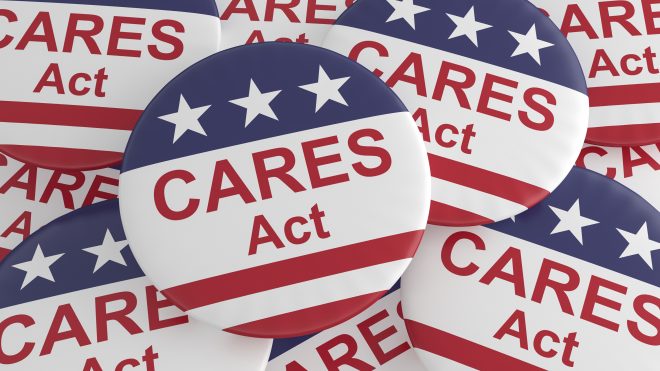Individuals are now able to file for unemployment under the emergency unemployment insurance CARES Act. This opens the door for those who were not eligible for benefits under previous rules — self-employed individuals, gig workers, independent contractors, small business owners, and others.
Congress’s latest Coronavirus relief package, the Coronavirus Aid, Relief, and Economic Security (CARES) Act, is the largest economic relief bill in U.S. history and will allocate $2.2 trillion in support to individuals and businesses affected by the pandemic and economic downturn. Today, CKS Summit Group explains how the new law impacts families and businesses alike.
What is the CARES Act?
The IRS announced that checks, up to $1,200 per individual or $2,400 per married couple, plus $500-per-child payments for eligible households, may start going out as early as April 9, though some Americans won’t get theirs for months to come. Importantly, the CARES Act also includes changes to both defined contribution and defined benefit retirement plans, as well as other changes affecting America’s retirement vehicles.
This is all part of the $2 trillion stimulus package passed by Congress and signed by President Donald Trump last month. The act creates temporary unemployment insurance, a program for individuals for who do not otherwise normally qualify for for unemployment insurance benefits, but would be working if not for COVID-19. This includes the self-employed, independent contractors, gig economy workers, and those who have a limited work history.
Main Highlights of the Act
As well as the use of retirement funds (see more below), this legislation covers many other areas for individuals and businesses negatively impacted by the Coronavirus outbreak.
Here Forbes breaks down some of the key provisions included in the bill and what that may mean for you:
- Direct payments: Americans who pay taxes will receive a one-time direct deposit of up to $1,200, and married couples will receive $2,400, plus an additional $500 per child. The payments will be available for incomes up to $75,000 for individuals and $150,000 for married couples.
- Unemployment: The program provides $250 billion for an extended unemployment insurance program and expands eligibility and offers workers an additional $600 per week for four months, on top of what state programs pay. It also extends UI benefits through Dec. 31 for eligible workers. The deal applies to the self-employed, independent contractors and gig economy workers.
- Payroll taxes: The measure allows employers to delay the payment of their portion of 2020 payroll taxes until 2021 and 2022.
- 401(k) Loans: The loan limit is increased from $50,000 to $100,000.
- Charity. There is a new provision that provides an above-the-line deduction for charitable contributions, plus, the limits on charitable contributions are changed.
- Small business relief: $350 billion is being dedicated to preventing layoffs and business closures while workers have to stay home during the outbreak. Companies with 500 employees or fewer that maintain their payroll during coronavirus can receive up to 8 weeks of cash-flow assistance. If employers maintain payroll, the portion of the loans used for covered payroll costs, interest on mortgage obligations, rent, and utilities would be forgiven.
- Net Operating Losses: The Tax Cuts and Jobs Act (TCJA) net operating loss rules are modified. The 80% rule is lifted, and losses can now be carried back five years.
- Excess Loss Limitations: The excess loss limitation (ELL) rules for pass-through entities are suspended.
- Interest Expense Limitation: The interest expense limitations are increased to 50% from 30% for tax years beginning in 2019 or 2020. Taxpayers can also elect to calculate the interest limitation for 2020 using their 2019 adjusted taxable income as the relevant base, which often will be significantly higher.
- Large corporations: $500 billion will be allotted to provide loans, loan guarantees, and other investments, these will be overseen by a Treasury Department inspector general. These loans will not exceed five years and cannot be forgiven. Airlineswill receive $50 billion (of the $500 billion) for passenger air carriers, and $8 billion for cargo air carriers.
- Hospitals and health care: The deal provides over $140 billion in appropriations to support the U.S. health system, $100 billion of which will be injected directly into hospitals. The rest will be dedicated to providing personal and protective equipment for health care workers, testing supplies, increased workforce and training, accelerated Medicare payments, and supporting the CDC, among other health investments.
- Coronavirus testing: All testing and potential vaccines for COVID-19 will be covered at no cost to patients.
- States and local governments: State, local and tribal governments will receive $150 billion. $30 billion is set aside for states, and educational institutions. $45 billion is for disaster relief, and $25 billion for transit programs.
- Agriculture: The deal would increase the amount the Agriculture Department can spend on its bailout program from $30 billion to $50 billion.
Relief in Retirement Accounts
The CARES Act is geared towards providing relief for businesses, but it does contain provisions that change rules about retirement plans for 2020: The Internal Revenue Code generally imposes a 10% early withdrawal penalty on distributions from a retirement plan taken prior to a participant being at least 59½ years old or qualifying for another exception.
The CARES Act, however, waives the 10% penalty for “coronavirus-related” distributions. A coronavirus-related distribution is one that is made to an individual:
- Whose spouse or dependent is diagnosed with such virus;
- Who experiences adverse financial consequences as a result of being quarantined, being furloughed, getting laid off, having work hours reduced, being unable to work due to lack of child care, having a business closing, or experiencing reduced hours.
Also of note, a coronavirus-related distribution may be included in income over a three-year period.
RMDs
Required minimum distributions (RMDs) from IRAs, 401(k)s, 403(b)s and other retirement plans have been suspended for 2020. At least part of the rationale likely was that the RMDs are based off year-end 2019 balances, current account balances are generally much lower based on the drop in the markets in the wake of the coronavirus.
The waiver includes RMDs for those who reached age 70½ and who would be required to take their first RMD by April 1 of 2020. This waiver also includes RMDs from inherited IRAs for 2020.
Combined with the SECURE Act that moved the commencement of RMDS for those who had not reached age 70½ before January 1, 2020, to age 72, this has effectively pushed the initial RMD back several years for those who turn 70½ in 2020.
How Will This be Administered?
States currently are awaiting further federal guidance as to how to administer the new benefits. As a result, there may be a delay in benefits for covered individuals but, regardless of the delay, covered individuals should receive payment for all eligible periods of unemployment.
Employers and claimants should monitor their local government websites for any applicable state unemployment insurance programs for up-to-date guidance. Additionally, CKS Summit Group will continue to monitor these developments and inform our readers of any new guidance in this area.
If you have any questions regarding your retirement plans and the potential impact of the new legislation on them, please contact the team at CKS Summit Group here.
For more information, you can see the full Bill, here.



